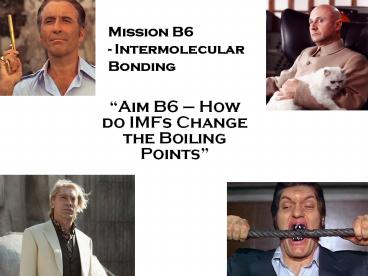Mission B6 - Intermolecular Bonding - PowerPoint PPT Presentation
1 / 15
Title: Mission B6 - Intermolecular Bonding
1
Mission B6 - Intermolecular Bonding
- Aim B6 How do IMFs Change the Boiling Points
2
Bonding in non-Molecules
- Ionic solids
- held by ionic bonds between all the ions
- Metallic solids
- are atoms of a metal bound to each other in a sea
of mobile electrons - Network solids
- diamond and sand have all their atoms bound
together - All have high melting points due to these bonds
3
Intermolecular Forces
- Individual molecules in a molecular solid are
held together by covalent bonds - BUT molecular solids are not!
- There are three types of molecule - to - molecule
attractions in molecular solids called
intermolecular forces or IMFs - London forces (aka Van der Waals forces)
electrons of one atom can attract the protons of
another in a very weak bond - Dipole-dipole interactions the mini magnet
effect - H-bonds a special case of the mini magnet
effect
4
The Weakest - London Forces
- London Dispersion Forces
- Protons have attractions for electrons
- both their own and other atoms
- A very weak bond occurs between atoms due to
these attractions - Example
- helium molecules
- monoatomic molecules
5
The Weakest - London Forces
- London Dispersion Forces
- The larger the molecules
- The more electrons / protons
- The greater the attraction
- between the two molecules
- The greater the boiling point
- Examples
- BP of Neon -246oC
- BP of Argon -186oC
- BP of Krypton -152oC
- BP of Xenon -107oC
Increasing molar masses
6
London Forces
- London forces
- Tend to raise melting and boiling points
- Due in part to masses of molecules
- RELATIONSHIP
- The larger the molecules
- the greater the London
- forces, and the higher
- the MP and BP
- Which of these two molecules
- has stronger London forces?
7
A little Bit Stronger- Dipole-Dipole Interactions
- A polar covalent bond occurs
- between each H and O in
- water H2O
- But not an even sharing
- Due to electronegativity differences
- Electrons spend more time around oxygen
- Oxygen becomes slightly (-), H becomes slightly
() - A mini magnet or dipole is formed
8
Dipole-Dipole Interactions
- Dipole- dipole interactions
- Positive ends of dipole
- attracted to the negative ends of other dipoles
- Again, electrostatic effect or mini magnet
effect
9
Polarity and Molecular Symmetry
- Polar molecules are dipoles they are
asymmetrical molecules - Shape affects polarity!
- Linear shapes
- with different atoms attached
- Ex hydrogen chloride (HCl)
- Angular shapes
- bent
- Ex water (H2O)
- Pyramidal shapes
- like a tripod
- Ex ammonia (NH3)
- Note all have polar bonds too!
10
Polarity and Molecular Symmetry
- Nonpolar molecules are symmetrical
- They DO NOT form dipoles!
- Linear shapes
- with same atoms on each end
- Ex carbon dioxide (CO2)
- Tetrahedral shapes
- Four sided pyramid shape
- All corners have same elements
- Ex methane (CH4)
- Note even though they have polar bonds, the
whole molecule is nonpolar due to symmetry!
11
Dipole-Dipole Interactions
- Keep in mind!
- London Forces occur in all molecules
- Many molecules also have dipole-dipoles
- Question what will happen to the boiling point
of similar sized particles, one that is nonpolar
with only London Forces, and the other with polar
molecules with dipole-dipole interactions? - HIGHER MELTING / BOILING POINTS
12
The ultimate force HYDROGEN BONDING
- Hydrogen bonding
- Special form of dipole-dipole interaction
- Occurs in molecules with
- Hydrogen atoms
- And small atoms
- Much stronger form of dipole bonding
- Reason for the boiling point of water being only
100oC
Hydrogen sulfide molecule
Water molecule
13
Boiling points of hydrogen compounds
14
When Ions and Molecules Collide! Dissolving -
Molecule-Ion Attractions
- NaCl dissolves in water (a given)
- This is due to the attraction of the () and (-)
ends of the polar water molecules to the Na ions
and Cl- ions dissolved in the water - Hydration - water molecules surround the ions,
separating them and thus dissolving the solid
15
Molecule-Ion Attractions Dissolving
- Sodium chloride and other ionic substances dont
dissolve in oil! - No hydration occurs
- Oil is nonpolar
- Main reason for oil and water not mixing
- Always remember Like dissolves like
- Polar dissolves polar
- Salt, sugar, in water
- Nonpolar dissolves nonpolar
- Oil paint in turpentine, styrofoam in acetone































